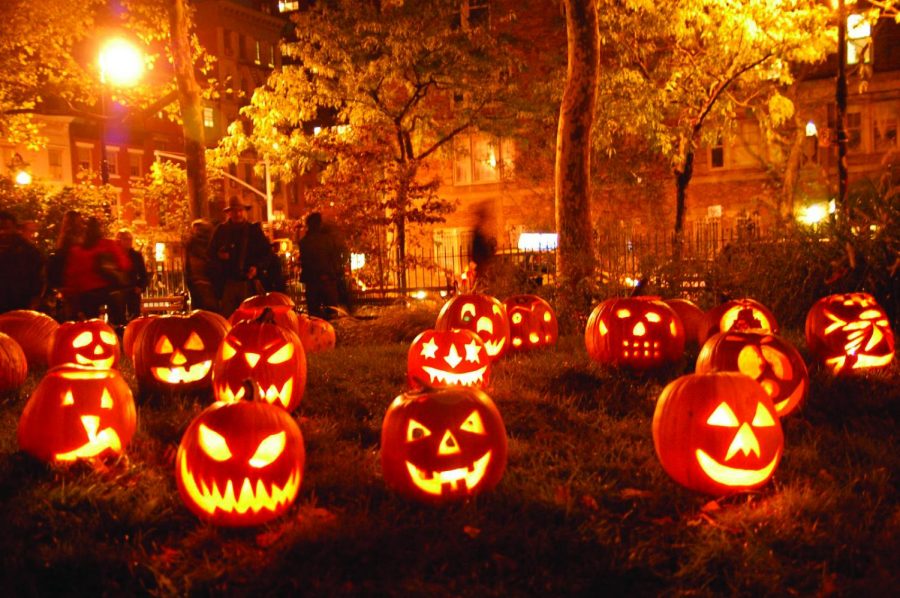Halloween’s Haunted History
October 30, 2017
As the end of October is nigh and winter draws near, the time of Halloween, a well known and celebrated holiday in America, creeps right around the corner. Families decide what costumes to wear, decorations are used to bring fright and terror, and candy is bought to give candy to all the trick-or-treaters who stop by that night, but how has Halloween become what it is today? What fateful twists and turns manipulated October 31st to become the day of Halloween?
The origins Halloween traces back to an ancient festival of Samhain. The Celts, who lived more than 2,000 years ago in what is now part of Ireland, celebrated Samhain on October 31st, for November 1st was the start of their new year. This day marked the end of summer and the harvest and the start of the dreaded and dark winter, a time of year that is often associated with death. The Celts believed that on October 31st, the boundary between the living and the dead dwindles and dead spirits return to the Earth.
Other than just causing problems, the Celts believed that the presence of spirits made it easier for the Druids, or priests, to make predictions about the future. To commemorate the event, Druids built huge sacred bonfires where people made sacrifices to the Celtic deities and wore costumes consisting of animal heads and skins and attempted to tell on another’s fortunes. When the celebration is over, they re-light their hearth fires from the sacred fire to help protect them during the long, cold winter.
By 43 A.D., the majority of the Celtic territory was conquered by the Roman Empire. For four hundred years, they combined two festivals of Roman origin with the Celtic festival of Samhain. The first was Feralia, a day in late October to commemorate the dead and the second was to honor Pomona, the goddess of fruit and trees.
On May 13, 609 A.D, Pope Boniface IV dedicated the pantheon in Rome in honor of all Christian martyrs. Pope Gregory III later expanded the festival to include all saints as well as all martyrs and moved the observance from May 13 to November 1.
In 1000 A.D., the church would make November 2 All Souls’ Day, a day to honor the dead. All Souls’ Day was celebrated similarly to Samhain with huge bonfires, parades, and dressing up in costumes of saints, devils, and angels. The All Saints Day celebration was also called All-hallows or All-hallowmas and the night before it, the traditional night of Samhain in the Celtic region, began to be called All-Hallows Eve, and eventually Halloween.
On Halloween, people believed if you were to leave you home you would encounter ghosts. To avoid these ghosts when leaving their homes, people would wear masks so ghosts would mistake them for fellow spirits, which leads to why people dress up in costumes. To prevent ghosts from entering their homes, people would leave bowls of food to appease the spirits.
For the festivities, poor people would beg for food and families would give them pastries called “soul cakes” in return for their promise they would pray for the family’s dead relatives. Distribution of soul cakes was encouraged by the church as a way to replace the ancient practice of leaving food and wine for roaming spirits. This practice was eventually taken up by children who would visit the houses in their neighborhood and receive food, ale, and money. A practice that later became known today as trick-or-treating.
At first, Halloween was not a major holiday celebrated in America when it came into existence due to many of the people being of Christian belief. When the Irish potato famine occurred in the 1850s, many Irish immigrants introduced their culture into America and a piece of it was their holiday Halloween.
The Irish also brought the tradition of carving pumpkins into Jack-o-Lanterns in America. However, the Jack-o-Lantern was not originally a pumpkin at first. Pumpkins did not exist in Ireland. Though, the ancient Celtic cultures of Ireland carved turnips on All-Hallow’s Eve and lit embers in them to ward off evil spirits.
By 1920s, Halloween became a community centered holiday with parades and town-wide parties, however, vandalism began to plague many communities during these times. By 1950s, the town leaders had successfully limited the amount of vandalism and Halloween became more directed toward the youth. Families could prevent tricks from being played on them by providing them with small treats.
Thus, these events shape the way we know Halloween to be today with children dressing up in costumes of their favorite characters and going street from street collecting candy and goods from generous families, houses being decorated with props relating to the supernatural and undead, entertainment directly influenced by fright and horror, and having community parties with games, food, and fun to celebrate the progression of fall into the winter.
Mr. Thomas, 11th grade U.S. history teacher at Pitman, shares his thoughts of how Halloween impacts families and communities today,
“Halloween allows people to dress in fun costumes and go out and meet the people of the community while having fun. Other holidays such as Christmas,Thanksgiving, and Easter are mostly family based and happen inside the home. Whereas Halloween gives families a chance to traverse the streets for the day and meet new people in the community.”
Come join the Downtown Halloween Trick or Treat Event on Tuesday, October 31, 2017 from 11:00am-2:00pm! The Downtown Businesses in Turlock will be handing out candy to all the spooky, fun kiddos dressed up!
